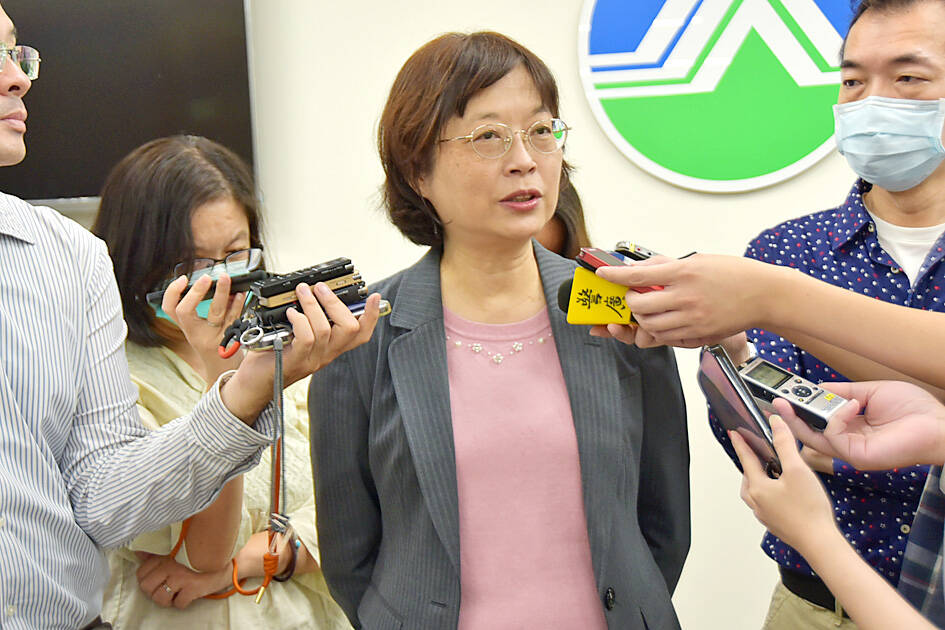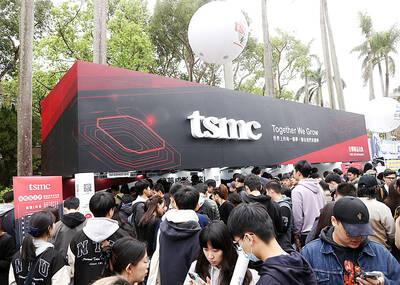The Ministry of Environment on Thursday announced regulations governing how entities can produce carbon credits or offset their emissions as part of Taiwan’s bid to hit its net zero emissions target.
Two new regulations would oversee how entities manage their carbon emissions: One governs “voluntary reduction projects” by businesses and government entities and the other one governs emissions generated by businesses on development and construction projects, the ministry said.
The first regulation states that entities that emit less than 25,000 metric tonnes of carbon dioxide — and are therefore not subject to the carbon fee — would be eligible to undertake “voluntary carbon emission reduction projects” that follow the internationally accepted measurable, reportable and verifiable guidance.

Photo: Wu Po-hsuan, Taipei Times
The reductions would need to have the characteristics of “additionality, avoiding overestimation, permanence, exclusive claim to GHG [greenhouse has] reductions, and avoiding social and environmental harms,” the Climate Change Administration Deputy Director-General Huang Wei-ming (黃偉鳴) said.
He said “additionality” meant that reductions would have to be made in addition to what entities are already doing to conform to the country’s existing environment-related legislation such the Air Pollution Control Act (空氣汙染防制法).
The voluntary projects would be categorized into the “removal type” or the “reduction or avoidance type,” with carbon removal meaning the elimination of existing carbon emissions, and carbon reduction or avoidance meaning the technology-based reductions of emissions.
Entities that emit more than 25,000 metric tonnes a year — the carbon fee payers — would not be eligible for the “voluntary projects,” as they are obligated to cut emissions, the administration said.
They would be able to purchase carbon credits produced by those who participate in voluntary projects to partially offset their carbon fees, and if they reach a certain reduction goal, they would be granted a preferential carbon fee rate.
The second regulation would require those setting up new factories emitting more than 25,000 metric tonnes a year, or high-rise construction projects, to partially offset their newly generated emissions, either by buying carbon credits from voluntary projects or by implementing other offsetting measures.
Offsetting measures generating “quasi-carbon credits” include replacing motorcycles running on fuel with electric ones, using high-efficiency air-conditioning and replacing old agricultural machines.
Huang said the objective of “quasi-carbon credits” is to shift the burden of promoting electric motorcycles and other energy-efficient products from government to big businesses.

CAUTION: Based on intelligence from the nation’s security agencies, MOFA has cautioned Taiwanese travelers about heightened safety risks in China-friendly countries The Ministry of Foreign Affairs (MOFA) yesterday urged Taiwanese to be aware of their safety when traveling abroad, especially in countries that are friendly to China. China in June last year issued 22 guidelines that allow its courts to try in absentia and sentence to death so-called “diehard” Taiwanese independence activists, even though Chinese courts have no jurisdiction in Taiwan. Late last month, a senior Chinese official gave closed-door instructions to state security units to implement the guidelines in countries friendly to China, a government memo and a senior Taiwan security official said, based on information gathered by Taiwan’s intelligence agency. The

The National Immigration Agency (NIA) said yesterday that it will revoke the dependent-based residence permit of a Chinese social media influencer who reportedly “openly advocated for [China’s] unification through military force” with Taiwan. The Chinese national, identified by her surname Liu (劉), will have her residence permit revoked in accordance with Article 14 of the “Measures for the permission of family- based residence, long-term residence and settlement of people from the Mainland Area in the Taiwan Area,” the NIA said in a news release. The agency explained it received reports that Liu made “unifying Taiwan through military force” statements on her online

Taiwan Semiconductor Manufacturing Co (TSMC), the world’s largest contract chipmaker, said yesterday that it is looking to hire 8,000 people this year, at a time when the tech giant is expanding production capacity to maintain its lead over competitors. To attract talent, TSMC would launch a large-scale recruitment campaign on campuses across Taiwan, where a newly recruited engineer with a master’s degree could expect to receive an average salary of NT$2.2 million (US$60,912), which is much higher than the 2023 national average of NT$709,000 for those in the same category, according to government statistics. TSMC, which accounted for more than 60 percent

Tung Tzu-hsien (童子賢), a Taiwanese businessman and deputy convener of the nation’s National Climate Change Committee, said yesterday that “electrical power is national power” and nuclear energy is “very important to Taiwan.” Tung made the remarks, suggesting that his views do not align with the country’s current official policy of phasing out nuclear energy, at a forum organized by the Taiwan People’s Party titled “Challenges and Prospects of Taiwan’s AI Industry and Energy Policy.” “Taiwan is currently pursuing industries with high added- value and is developing vigorously, and this all requires electricity,” said the chairman